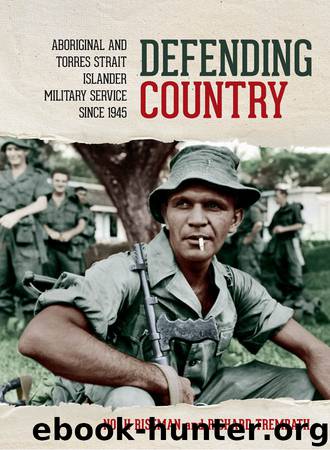Defending Country: Aboriginal and Torres Strait Islander Military Service Since 1945 by Noah Riseman & Richard Trembath

Author:Noah Riseman & Richard Trembath
Language: eng
Format: mobi, epub
Publisher: University of Queensland Press
Published: 2016-03-31T21:00:00+00:00
6
A changing defence force
and Reconciliation
I enjoyed the Army, I made some great friends. I believe that a lot of our young, unemployed people should join the Army for discipline and friendship wise, and you can earn a living in there. It was one of my greatest times, I think.1
– Japarta Maurie Ryan
Bringing people of NESB [non-English speaking background] and Aborigines and Torres Strait Islanders into the ADF may help to give the ADF a broader appreciation of other cultures and the way they may respond to Australian strategic and security planning.2
– ‘The Ethnic Composition of the Australian Defence Force’, 1993
In his landmark 1992 Redfern address, Prime Minister Paul Keating asked all Australians to imagine themselves in the position of Indigenous Australians. He reflected on the long history of Aboriginal and Torres Strait Islander dispossession, discrimination and erasure from Australia’s national consciousness. He also declared: ‘Imagine if non-Aboriginal Australians had served their country in peace and war and were then ignored in history books.’3 Keating’s Redfern address is considered one of the most significant markers of the Reconciliation movement of the 1990s. The formal Reconciliation process grew out of recommendations from the 1991 Royal Commission into Aboriginal Deaths in Custody. Subsequently, the Commonwealth government established the Council for Aboriginal Reconciliation in 1991 with the ten-year aim to promote: better relationships between Indigenous and non-Indigenous Australians, knowledge of shared histories, understandings of Indigenous disadvantage, appreciation of Indigenous cultures and a document expressing new relationships between Indigenous and non-Indigenous Australians. The nebulous nature of the term Reconciliation was always open to interpretation, leaving what many consider unfinished business at the end of the formal process in 2001.4
Throughout the Reconciliation movement, public and private institutions were all encouraged to participate by thinking about what they as organisations could do to promote the ideals of Reconciliation. As Keating’s Redfern address suggested, the ADF was not immune from this process. Given the long history of Aboriginal and Torres Strait Islander participation in the armed forces, it is not surprising that the ADF, the Department of Defence and the Department of Veterans’ Affairs had the potential to play significant roles to promote Reconciliation. The defence community responded to the call for Reconciliation in numerous ways – some well before Reconciliation became a popular term, and others more recently. The success of Reconciliation within the defence community stems from organisations’ willingness to work at the grassroots level with local Indigenous communities, whether they are in remote or urban areas. Some of the more pronounced examples discussed in this chapter include the special role of Indigenous defence networks in remote Top End units, anti-racism and Reconciliation Action Plans across the ADF and the Department of Defence, and special programs promoting Indigenous service in the ADF. These new initiatives also align with the changing strategic and operational dynamics of the ADF since the late 1980s.
Regional Force Surveillance Units
In 2001 the then chief of army (now governor-general of Australia), Peter Cosgrove, wrote that in the decade after the end of the
Download
Defending Country: Aboriginal and Torres Strait Islander Military Service Since 1945 by Noah Riseman & Richard Trembath.epub
This site does not store any files on its server. We only index and link to content provided by other sites. Please contact the content providers to delete copyright contents if any and email us, we'll remove relevant links or contents immediately.
The Secret History by Donna Tartt(18849)
The Social Justice Warrior Handbook by Lisa De Pasquale(12142)
Thirteen Reasons Why by Jay Asher(8796)
This Is How You Lose Her by Junot Diaz(6795)
Weapons of Math Destruction by Cathy O'Neil(6146)
Zero to One by Peter Thiel(5686)
Beartown by Fredrik Backman(5599)
The Myth of the Strong Leader by Archie Brown(5425)
The Fire Next Time by James Baldwin(5249)
How Democracies Die by Steven Levitsky & Daniel Ziblatt(5128)
Promise Me, Dad by Joe Biden(5087)
Stone's Rules by Roger Stone(5026)
A Higher Loyalty: Truth, Lies, and Leadership by James Comey(4845)
100 Deadly Skills by Clint Emerson(4840)
Rise and Kill First by Ronen Bergman(4704)
Secrecy World by Jake Bernstein(4646)
The David Icke Guide to the Global Conspiracy (and how to end it) by David Icke(4626)
The Farm by Tom Rob Smith(4438)
The Doomsday Machine by Daniel Ellsberg(4416)
